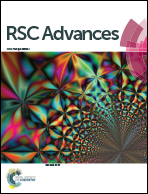Restricted binding of a model protein on C3N4 nanosheets suggests an adequate biocompatibility of the nanomaterial†
Abstract
Recently, C3N4, a carbon nitride nanomaterial, has attracted great attention in many scientific fields due to its outstanding properties. Specifically, this nanomaterial has displayed non- or low-toxicity in biological systems suggesting its excellent biocompatibility and biosafety. Nevertheless, few studies address the structural consequences from the direct interaction between C3N4 and biomolecules that could imply the physical origin of its bio-effect, particularly from the molecular level. Herein, we explored the interaction of a C3N4 nanosheet and a model protein, the λ-repressor protein. We found that the C3N4 nanosheet has a limited influence on the structure of the λ-repressor protein, which substantiates the outstanding biocompatibility of the nanomaterial. Detailed analyses showed that upon absorption on the C3N4 nanosheet, the λ-repressor protein remains located in a relatively fixed position without compromising the structural integrity of the protein. Furthermore, the protein-nanomaterial interaction is mediated by positively charged residues located on the surface of the protein and by the regional negatively charged center on the C3N4 nanosheet (i.e., N-rich defects). These findings provide further molecular-level insights into the good biocompatibility of the C3N4 nanomaterial and also suggest its potential usage as a protein drug delivery platform.



 Please wait while we load your content...
Please wait while we load your content...